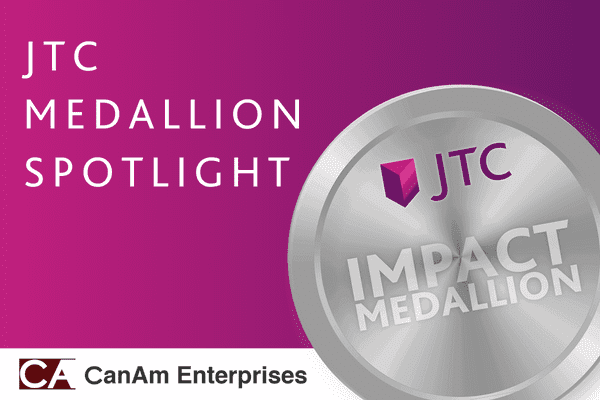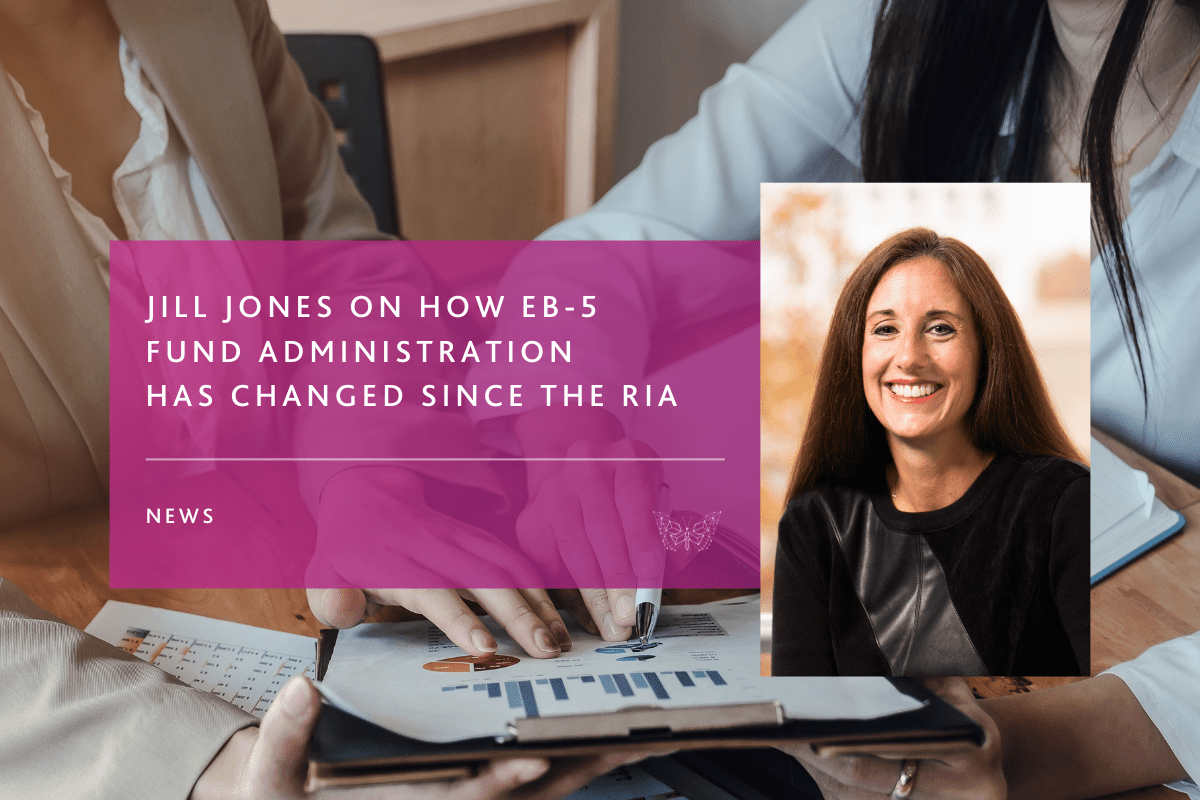CanAm’s Christine Chen looks back at the company’s role in the evolution of EB-5 and how understanding investor priorities helped guide the decision-making process.
The JTC Impact Medallion Program recognizes industry stakeholders who embrace best practices in security, transparency, and compliance.
The passage of the EB-5 Reform and Integrity Act of 2022 (RIA) brought a lot of new opportunities, particularly due to the newly-created reserved visa categories that have created a demand for rural projects. But many quickly realized evaluating rural projects and their suitability for EB-5 required knowledge not every issuer possessed. The RIA also instituted integrity measures to combat fraud and abuse, and those best equipped to meet these compliance challenges were those already providing increased security and transparency for their investors.
Few names have become as synonymous with EB-5 as CanAm Enterprises. With more than 50 EB-5 projects repaid, resulting in over $2 billion in repaid capital and more than 8,000 permanent green cards, CanAm has helped thousands of investors on their journeys toward permanent residency in the United States.
CanAm’s partner companies include CanAm Capital Partners, LLC, a New York City-based private equity real estate investor and manager, CanAm Capital Management (CACM), a SEC registered advisory firm, as well as CanAm Investor Services (CAIS), a licensed broker-dealer. With these three components, CanAm can work with investors through all phases of their EB-5 investments. By understanding the needs of immigrant investors, CanAm can focus on the types of projects that deliver the results most important to EB-5 applicants.
We spoke with Chief Operating Officer Christine Chen about what she’s learned from her history with EB-5, the changes brought about by the RIA, and why selecting the right investment project requires a deep understanding of what’s at stake for investors.
CanAm has been in the EB-5 business for over 20 years now. How has EB-5 changed in that time? Are investors more sophisticated than they used to be? Are expectations higher?
Chen: EB-5 has changed in so many ways over the past 20 years as the program has gained credibility and popularity as a path towards permanent residency. Many investors are now financial professionals themselves and require much more sophisticated analysis before making a decision. I think the increased investor due diligence is also a result of, unfortunately, past fraud in the EB-5 program and failed projects. Investors are more aware of the importance of choosing the right EB-5 Regional Center and asking the right questions about potential projects. This is not an investment you should take any unnecessary risk with. And of course, the uncertainty and volatility we see in financial markets has led to a more conservative approach by investors.
I am not sure that expectations of the program are higher per se, but expectations on transparency are much higher – from the beginning of the discussion about our selection and underwriting of the EB-5 deal to well after their petitions are filed and they are reviewing their investment project updates for the life of the investment. At CanAm, we’ve always understood how important and personal an EB-5 investment is and we welcome that scrutiny. We’ve always said that EB-5 investors should ask us all the hard questions. It’s our job to make sure we’ve already asked them ourselves.
Looking back on your time in EB-5, what are some of the major highlights? Were there moments that changed the way you thought about EB-5 as an immigration program and an impact initiative? Do you evaluate potential investments differently now than you did in the past?
Chen: We’ve been in EB-5 long enough now that we’ve had some hard-won battles with USCIS – notably, about whether the “loan model” met the at-risk requirement, and then about material change during the life of the EB-5 investment. Right after we started in EB-5, our investment structure was questioned by USCIS and eventually went up to the AAO [Administrative Appeals Office], the only EB-5 case to have done so, and the AAO ultimately ruled that our “loan model” met all the at-risk requirements; it immediately became the standard for EB-5 for a long time. Later, during the Great Recession, when so many projects that were “shovel ready” suddenly lost their financing, we managed to transfer our investors’ EB-5 capital to projects that created the required jobs, and there was nothing in the regulations prohibiting that. We litigated that case and won, but shortly thereafter, USCIS came out with its guidance on material change, which provided much more clarity to Regional Centers, immigration attorneys, and investors alike.
We’ve had some really meaningful projects over the years that we know had real impact on business owners and communities, from small family-owned businesses where EB-5 has been part of their success and growth story over the years to government projects where EB-5 helped build city and state infrastructure. For our All Aboard Florida project, the EB-5 loan was part of a $3 billion project that built rail from Miami to Orlando – that’s really kind of amazing. And it was repaid on time during the pandemic, the largest EB-5 repayment in history. These have been important milestones and successes for CanAm, for sure, but also for the EB-5 industry as a whole. We always want to do projects that validate how beneficial the EB-5 Program is to the United States.
We always take a fairly conservative stance on underwriting and structuring when we evaluate potential EB-5 deals, but our approach isn’t static. Office is something we did a lot of previously but are continuing to steer clear of now. We’ve never done a lot of hospitality, but the questions we are asking of prospective hospitality deals is quite different after COVID. With our rural area deals, we have found a lot of complementarities between EB-5 and industry sectors that are granted legislative incentives, such as rural broadband and alternative energy. With how much more restrictive banking has been the past year since the SVB crisis, we are scrutinizing the requirements of senior lenders in prospective deals to make sure they don’t hold up the protections we want to secure for our EB-5 investors.
CanAm Enterprises has an affiliated broker-dealer, CanAm Investor Services. Can you tell us a little bit about why CAIS was established, how it helps investors, and the advantages of having an affiliated broker-dealer?
Chen: About 10-12 years ago, when the question of whether an EB-5 investment was a security or not was first asked, a lot of players in EB-5 were looking to be paid referral fees. And there were some in the industry who felt it was acceptable not to ask too many questions. We’ve always sought to do things by the letter of the law because we understand we are risking our investors’ EB-5 petitions as well as our reputation. We did what seemed the logical thing, which was consult with a securities attorney and go through the lengthy process of setting up our own broker-dealer. Our broker-dealer is accountable to FINRA, which makes it quite clear what we are and are not allowed to do.
Having had the broker-dealer for so many years now, it also meant that when the RIA was passed, we already had in place much of the procedures and paperwork that other operators had to scramble to establish. After all, we were already producing them for FINRA and the SEC. And because our broker-dealer sells CanAm deals, it means that all CanAm’s materials are scrutinized for compliance not just by our securities counsel but by the broker-dealer’s compliance consultants.
What have been the biggest changes you’ve noticed since the RIA’s passage? Have the increased integrity measures, concurrent filing of Adjustment of Status, and reserved visa categories changed CanAm’s strategy at all?
Chen: As I mentioned, we were already pretty well-positioned to meet the RIA’s integrity measures and other compliance requirements even before its passage, but the biggest game changers have been the reserved visa categories and concurrent filing.
CanAm was largely a Regional Center operator that specialized in urban projects and urban investments. It was not so much a pivot as a turning of the ship for us to source rural area EB-5 projects. Initially, we didn’t have any appetite for the projects we found in rural areas, which were largely manufacturing projects based on accounts receivables and start-ups. They didn’t necessarily have the conservative structure or strong sponsorship that has become characteristic of our deals. In time, we found certain industry sectors where serious sponsors were investing and there were substantive legislative incentives that demonstrated how important these industries were to the U.S. government. It really makes us proud that our EB-5 deals are funding the installation of broadband across rural areas to make those communities more competitive overall, giving broadband access to rural school districts and improving the way of life for the people of these communities.
With concurrent filing, we have found it very advantageous to have our broker-dealer. These are U.S. persons, and our licensed team is free to speak to them and answer all their questions about our projects.
Last question: if you could please look into your crystal ball, what do you foresee for EB-5 in 2024 and beyond? Will we see more rural and infrastructure projects, or a change in where EB-5 investors come from? Is it possible EB-5 could grow, or will USCIS adjudication speed and visa availability limit the program’s potential?
Chen: Near-term I think that EB-5 projects will be almost exclusively rural for the next year. For retrogressed countries, the reason is obvious, but with priority processing, even non-retrogressed countries are seeking out only rural area deals. With the incredible urgency to file and secure a priority date these days, it feels a bit like 2017 and I worry that investors are not asking all the right questions. We have sometimes found ourselves in the position of pointing out the questions investors should be asking in this environment, to not just look at what is allowed right now, but where USCIS’ stance might be a few years from now. Rushing into a filing if you aren’t completely sure the EB-5 investment will hold up when it’s time to file the I-829 would be a disaster. With concerns about the rural category retrogressing in the next couple years, it’s more important than ever to choose the right investment now.
I think the next big hurdle we need to meet before reauthorization is building consensus within the EB-5 stakeholder community on visa reform, from Regional Center operators to service providers to investors alike. In the past, every time we spoke to legislators, they said if we would agree to program reform, which they have now, then we could discuss visas because that is the only true relief for the backlog. Regional Centers are paying the integrity fees, filing fees are going up, agents are registering – we are complying with all the RIA requirements, but the set-aside categories are only a short-term band-aid. Visa reform is a subject we can all get behind, and we need to find ways to unite the industry instead of dividing us.
Learn more about how JTC is helping EB-5 Issuers offer greater security, transparency, and compliance for investors.
Stay Connected
Stay up to date with expert insights, latest updates and exclusive content.
Discover more
Stay informed with JTC’s latest news, reports, thought leadership, and industry insights.
Let’s Bring Your Vision to Life
From 2,300 employee owners to 14,000+ clients, our journey is marked by stability and success.



















